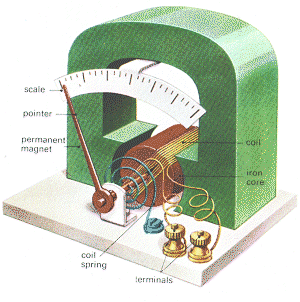
 |
How it works : Ammeter |
AMMETER
 |
Above: a moving coil ammeter. The current to be measured goes through the coil via the terminals, establishing a magnetic field which opposes the field of the surrounding permanent magnet. The coil rotates against the force of the coil spring and so moves the pointer. |
The ammeter measures electric current. The unit in which this is measured is the ampere, with the milliampere and micro- ampere used for very small currents. Current passing through the instrument moves a pointer over a scale by an amount dependent on the size of the current.
There are two basic types of ammeter. The moving coil type has a linear scale - that is, its divisions are equally spaced. Moving iron or moving magnet meters have a nonlinear scale.
The principle on which ammeters are based is that when a current is passed through a wire it sets up a magnetic field around the wire. Coiling the wire produces an ELECTRO MAGNET whose strength is proportional to the current.
The moving coil ammeter has three basic parts: a permanent magnet, a fiat coil pivoted at right angles to the magnet's field and carrying the instrument's pointer, and a coil spring. The moving coil and pointer assembly are pivoted, usually on jewelled bearings, and their rotation is held in check by the coil spring.
Passing the current to be measured through the coil sets up a magnetic field in opposition to that of the permanent magnet. This produces a force which makes the coil and pointer rotate.
Without the retaining coil spring, the result would be rotation of the coil until the two magnets no longer opposed each other. But the coil spring resists the rotation to a greater or lesser degree depending on the strength of the force twisting it. In this way, every position on the scale corresponds to a particular force and hence to a particular current.
In this form the ammeter measures direct current up to a fixed maximum known as full scale deflection - fsd. This can be as low as 25 microamperes in very sensitive instruments. Higher ranges can be added by shunt resistors connected across the coil. These then carry most of the current, allowing only a small proportion to flow through the coil.
Accuracy of such instruments is frequently within 1 or 200 of fsd, but much higher accuracies are available in laboratory instruments.
To measure alternating currents, RECTIFIERS which turn AC into DC have to be added to the shunt circuits.
A simpler and cheaper, though less sensitive and less accurate, method of measuring alternating currents is to use a moving iron ammeter.
In this instrument, the pointer is attached to a spring or counterbalance weight and to a piece of soft iron. There is another piece of iron fixed near the first. When the current to be measured passes through a coil surrounding the whole meter movement, magnetic fields are formed around the two pieces of iron, causing them to repel each other.
This causes the pointer to move against its retaining spring, hut this time its movement is nonlinear because the repulsive force falls off as the distance between the two pieces of iron increases.
If an alternating current is passed through the coil, the direction of the magnetic field which it induces in the two iron pieces changes with the same frequency as the current. But as the force between them is always one of repulsion, alternating currents with frequencies up to 300 Hz can be measured as well as direct currents. The instrument's high resistance and other failings together with the low cost of semiconductor rectifiers for use in moving coil ammeters have caused the moving iron meter to fall largely into disuse.
Currents can also be measured on all-electronic instruments which have no mechanical moving parts. These generally function as VOLTMETERS, measuring the proportional voltage drop across a resistor to indicate current. They have the advantages of extremely high accuracy and a digital display, which is easier to read than the position of a pointer, but at the moment they are much more expensive than electro mechanical types.
Reproduced from HOW IT WORKS p89